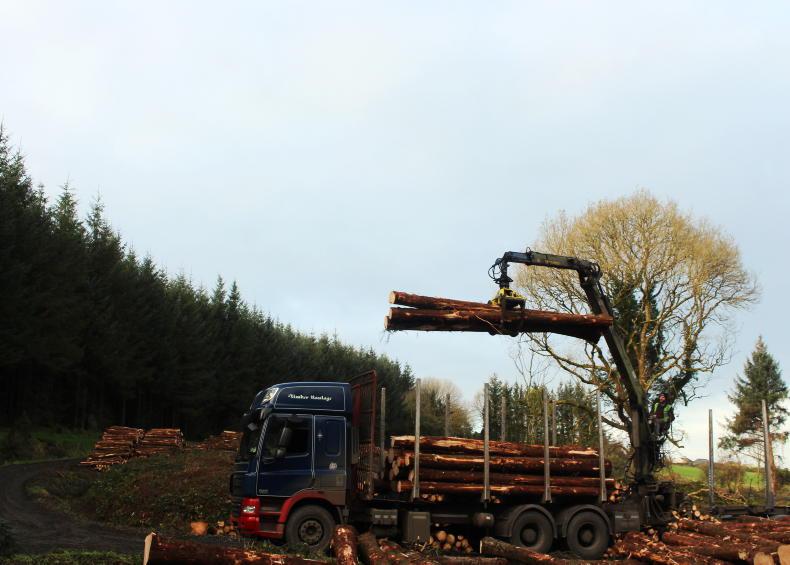Minister of State Pippa Hackett has marked her first full calendar year in office by “highlighting her achievements in 2021 and outlining her priorities for 2022”.
She also published the third interim report on the implementation of Project Woodland.
“Forestry has progressed,” she said.
“We still have issues with licensing, but this year we have issued over 4,000 so there have been great improvements and Project Woodland, which I launched in February, is bringing everyone together to address the bigger picture too.”
Afforestation
She acknowledged that “output on the afforestation side is still very low but my Department is prioritising it and will soon be producing more ambitious projections for licensing for 2022, with a focus on afforestation”.
Teige Ryan, director, None so Hardy Nurseries and chair of the Social, Economic Environmental Forestry Association of Ireland (SEEFA), said there was “little evidence of real progress” during the year. “By any yardstick, failure to achieve its own soft target of 4,500 licences for 2021 is a major disappointment,” he said.
“Celebrating 4,035 licences as an achievement is completely inappropriate. More useful information would be to offer some explanation why only 12% of all licences issued were for afforestation. This completely goes against the objectives of the Mackinnon report and his 21 recommendations, not one of which has been implemented in 2021.”
Padraig Egan, general manager, SWS Forestry, said 2021 “will be remembered as the year that farmers and landowners who wanted to plant were not allowed” due to the Department’s licensing delays. “The Department told us to undertake expensive and time-consuming ecology works at our own expense to speed up the process, which we did but still virtually no approvals were issued,” he said.
Minister Hackett maintained “the licensing of 8.4m m3 of timber is the highest on record” and said the “output on forest roads was equally impressive with 260km licensed – double our target”.
Egan said: “There is still a large backlog in private felling licences and many of these forests cannot be thinned now due to delays in licence approvals. We need a time-sensitive licensing system, similar to other planning.”
Pat O’Sullivan, technical director, Society of Irish Foresters, welcomed felling licences of 8.4m m3 but questioned the availability of this material on an annual basis as felling licences extend to 10 years.
“In the short-term the market needs an annual breakdown of thinning and cleafells especially for the private sector to get a true picture of volume availability,” he said.
“Longer term, licences for thinning should not be required but treated as a positive forest management operation.”
Project Woodland Interim Report
“This third interim report really highlights the enormous range of work ongoing under Project Woodland,” said Minister Hackett. “ The commencement of the legal and regulatory review, with strong interaction with the working groups, was acknowledged, as was the advancement of the development of the new Forestry Strategy, with a draft vision agreed,” she said.
“I believe this latest report of the project board should give us confidence that, while we are nowhere near the end of this process, progress to date indicates that we can achieve what we have set out to do.”
O’Sullivan, acknowledged the work of Project Woodland but said “the lack of a realistic time scale for completion shows lack of real direction by the minister and project board”.
He said: “The minister’s statement that Project Woodland is ‘nowhere near the end’ of its process demonstrates a real lack of urgency and commitment as it is now over two years since Mackinnon was adopted.”
Roundwood forecast estimates a 62% increase in log supply by 2035
Timber forecast predicts the annual log supply will increase from 4.7m m3 in 2021 to 7.9m m3 by 2035 when private production will exceed Coillte and Forest Service NI. \ Donal Magner
The All-Ireland Roundwood Production Forecast 2021-2040 predicts the annual potential log supply, will increase from 4.7m m3 in 2021 to 7.9m m3 by 2035, followed by a small decrease to 7.6m m3 up to 2040. As early as 2030, timber supply from private forests will be greater than Coillte and the Forest Service Northern Ireland combined.
Coillte annual production remains level throughout the forecast period at 2.7m m3 while private annual net realisable volume (NRV) is forecast to increase from 1.47m m3 to 4.43m m3 by 2035 with a fall-off in production to 4.18m m3 by 2040. Northern Ireland annual log production is forecast to increase by 55% to 790,000m3 over the next 15 years, falling back to 700,000m3 from 2035 to 2040.
The NRV forecast for Sitka and Norway spruce is 117.41m m3 or 87.8% of total volumes over the forecast period. Spruce dominates, as was the case in the previous forecast, where it accounted for 86% of total volume.
Lodgepole pine and other conifers account for 4.0% and 5.6% of total volume respectively, while broadleaves account for the remaining balance of 2.6% (broadleaf volume forecast data not available for Northern Ireland).
There are major challenges in producing volumes of this magnitude, especially for private growers.
Wood mobilisation will require a major improvement in felling and forest road licence approvals by the Department of Agriculture, Food and the Marine (DAFM) as well as capital expenditure in roads, harvesting machinery and transport and processing.
The report, published by COFORD, acknowledges the uncertainties in producing a forecast up to 2040.
Factors such as storm damage, fire, disease and drought along with the possible impact of climate change can all reduce timber production as we have seen in central Europe.
The All-Ireland Roundwood Production Forecast 2021-2040 is published by COFORD and is available through the COFORD link on the Department of Agriculture, Food and the Marine website.
An online tool accompanying the forecast allows users to generate their own regional forecast for an area of interest specified by the user.
Minister of State Pippa Hackett has marked her first full calendar year in office by “highlighting her achievements in 2021 and outlining her priorities for 2022”.
She also published the third interim report on the implementation of Project Woodland.
“Forestry has progressed,” she said.
“We still have issues with licensing, but this year we have issued over 4,000 so there have been great improvements and Project Woodland, which I launched in February, is bringing everyone together to address the bigger picture too.”
Afforestation
She acknowledged that “output on the afforestation side is still very low but my Department is prioritising it and will soon be producing more ambitious projections for licensing for 2022, with a focus on afforestation”.
Teige Ryan, director, None so Hardy Nurseries and chair of the Social, Economic Environmental Forestry Association of Ireland (SEEFA), said there was “little evidence of real progress” during the year. “By any yardstick, failure to achieve its own soft target of 4,500 licences for 2021 is a major disappointment,” he said.
“Celebrating 4,035 licences as an achievement is completely inappropriate. More useful information would be to offer some explanation why only 12% of all licences issued were for afforestation. This completely goes against the objectives of the Mackinnon report and his 21 recommendations, not one of which has been implemented in 2021.”
Padraig Egan, general manager, SWS Forestry, said 2021 “will be remembered as the year that farmers and landowners who wanted to plant were not allowed” due to the Department’s licensing delays. “The Department told us to undertake expensive and time-consuming ecology works at our own expense to speed up the process, which we did but still virtually no approvals were issued,” he said.
Minister Hackett maintained “the licensing of 8.4m m3 of timber is the highest on record” and said the “output on forest roads was equally impressive with 260km licensed – double our target”.
Egan said: “There is still a large backlog in private felling licences and many of these forests cannot be thinned now due to delays in licence approvals. We need a time-sensitive licensing system, similar to other planning.”
Pat O’Sullivan, technical director, Society of Irish Foresters, welcomed felling licences of 8.4m m3 but questioned the availability of this material on an annual basis as felling licences extend to 10 years.
“In the short-term the market needs an annual breakdown of thinning and cleafells especially for the private sector to get a true picture of volume availability,” he said.
“Longer term, licences for thinning should not be required but treated as a positive forest management operation.”
Project Woodland Interim Report
“This third interim report really highlights the enormous range of work ongoing under Project Woodland,” said Minister Hackett. “ The commencement of the legal and regulatory review, with strong interaction with the working groups, was acknowledged, as was the advancement of the development of the new Forestry Strategy, with a draft vision agreed,” she said.
“I believe this latest report of the project board should give us confidence that, while we are nowhere near the end of this process, progress to date indicates that we can achieve what we have set out to do.”
O’Sullivan, acknowledged the work of Project Woodland but said “the lack of a realistic time scale for completion shows lack of real direction by the minister and project board”.
He said: “The minister’s statement that Project Woodland is ‘nowhere near the end’ of its process demonstrates a real lack of urgency and commitment as it is now over two years since Mackinnon was adopted.”
Roundwood forecast estimates a 62% increase in log supply by 2035
Timber forecast predicts the annual log supply will increase from 4.7m m3 in 2021 to 7.9m m3 by 2035 when private production will exceed Coillte and Forest Service NI. \ Donal Magner
The All-Ireland Roundwood Production Forecast 2021-2040 predicts the annual potential log supply, will increase from 4.7m m3 in 2021 to 7.9m m3 by 2035, followed by a small decrease to 7.6m m3 up to 2040. As early as 2030, timber supply from private forests will be greater than Coillte and the Forest Service Northern Ireland combined.
Coillte annual production remains level throughout the forecast period at 2.7m m3 while private annual net realisable volume (NRV) is forecast to increase from 1.47m m3 to 4.43m m3 by 2035 with a fall-off in production to 4.18m m3 by 2040. Northern Ireland annual log production is forecast to increase by 55% to 790,000m3 over the next 15 years, falling back to 700,000m3 from 2035 to 2040.
The NRV forecast for Sitka and Norway spruce is 117.41m m3 or 87.8% of total volumes over the forecast period. Spruce dominates, as was the case in the previous forecast, where it accounted for 86% of total volume.
Lodgepole pine and other conifers account for 4.0% and 5.6% of total volume respectively, while broadleaves account for the remaining balance of 2.6% (broadleaf volume forecast data not available for Northern Ireland).
There are major challenges in producing volumes of this magnitude, especially for private growers.
Wood mobilisation will require a major improvement in felling and forest road licence approvals by the Department of Agriculture, Food and the Marine (DAFM) as well as capital expenditure in roads, harvesting machinery and transport and processing.
The report, published by COFORD, acknowledges the uncertainties in producing a forecast up to 2040.
Factors such as storm damage, fire, disease and drought along with the possible impact of climate change can all reduce timber production as we have seen in central Europe.
The All-Ireland Roundwood Production Forecast 2021-2040 is published by COFORD and is available through the COFORD link on the Department of Agriculture, Food and the Marine website.
An online tool accompanying the forecast allows users to generate their own regional forecast for an area of interest specified by the user.








 This is a subscriber-only article
This is a subscriber-only article










SHARING OPTIONS: